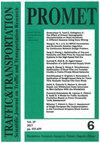飞行训练大纲结构对灵活空域结构下高性能军机飞行员训练作业主动规划的影响
IF 1.1
4区 工程技术
Q4 TRANSPORTATION SCIENCE & TECHNOLOGY
引用次数: 0
摘要
欧洲空域的特点是碎片化,碎片化导致了拥堵。空域灵活利用是解决空域拥挤问题的解决方案,其核心是军民合作和空域使用协调。这种方法是通过协同决策实现的,它假设空域用户之间及时和完整地交换完整的相关信息。为了参与这一进程,军方应该对其限制和适应其他空域使用者需求的能力保持透明。飞行训练大纲结构及其对灵活空域结构下高性能军机飞行员训练作业主动规划的具体影响是本研究的主题。萨格勒布FIR灵活空域结构中民用交通需求小时分布的显著多样性证明了它们适用于高性能飞机飞行员培训操作规划和管理的主动方法。在拥挤的飞行高度的灵活空域结构中,高性能飞机飞行员训练行动所影响的民用飞机数量明显减少。高性能飞机飞行员训练操作的主动规划模拟揭示了飞行大纲结构对飞行员飞行训练持续时间的影响,以及管理其限制的可能性。本文章由计算机程序翻译,如有差异,请以英文原文为准。
Flight Training Syllabus Structure Impact on Proactive Planning of High-Performance Military Aircraft Pilot Training Operations in Flexible Airspace Structures
European airspace is marked by fragmentation, and from fragmentation originated congestion. As an answer to congestion, flexible use of airspace is created to fulfil all users’ requirements optimally, and at its very core lies civil-military cooperation and the coordination of airspace use. Such an approach is enabled by collaborative decision-making, which presumes timely and complete exchange of complete relevant information between airspace users. To participate in the process, the military should be transparent regarding its restrictions and capabilities of adaptation to other airspace users’ demands. Flight training syllabus structure and its specific impact on proactive planning of high-performance military aircraft pilot training operations in flexible airspace structures is the subject of this research. Significant diversity in the hourly distribution of civil traffic demand in flexible airspace structures in Zagreb FIR proves them applicable for a proactive approach to high-performance aircraft pilot training operations planning and management. Noticeable reduction in the number of civil aircraft affected by high-performance aircraft pilot training operations in flexible airspace structures at congested flight levels is corroborated. Simulations of proactive planning of high-performance aircraft pilot training operations reveal indications of flight syllabus structure’s impact on pilot flight training duration, as well as the possibility to manage its restrictions.
求助全文
通过发布文献求助,成功后即可免费获取论文全文。
去求助
来源期刊

Promet-Traffic & Transportation
工程技术-运输科技
CiteScore
1.90
自引率
20.00%
发文量
62
审稿时长
3 months
期刊介绍:
This scientific journal publishes scientific papers in the area of technical sciences, field of transport and traffic technology.
The basic guidelines of the journal, which support the mission - promotion of transport science, are: relevancy of published papers and reviewer competency, established identity in the print and publishing profile, as well as other formal and informal details. The journal organisation consists of the Editorial Board, Editors, Reviewer Selection Committee and the Scientific Advisory Committee.
The received papers are subject to peer review in accordance with the recommendations for international scientific journals.
The papers published in the journal are placed in sections which explain their focus in more detail. The sections are: transportation economy, information and communication technology, intelligent transport systems, human-transport interaction, intermodal transport, education in traffic and transport, traffic planning, traffic and environment (ecology), traffic on motorways, traffic in the cities, transport and sustainable development, traffic and space, traffic infrastructure, traffic policy, transport engineering, transport law, safety and security in traffic, transport logistics, transport technology, transport telematics, internal transport, traffic management, science in traffic and transport, traffic engineering, transport in emergency situations, swarm intelligence in transportation engineering.
The Journal also publishes information not subject to review, and classified under the following headings: book and other reviews, symposia, conferences and exhibitions, scientific cooperation, anniversaries, portraits, bibliographies, publisher information, news, etc.
 求助内容:
求助内容: 应助结果提醒方式:
应助结果提醒方式:


